Assessing the Protective Capacity of Aquifers Using Very-Low-Frequency Electromagnetic Survey
Abstract
:1. Introduction
2. Description of the Study Area
2.1. Location
2.2. Geologic Setting
3. Materials and Methods
Acquisition of VLF-EM Data
4. Results
Borehole and VES
5. Discussion
6. Conclusions
Author Contributions
Acknowledgments
Conflicts of Interest
References
- Lobo-Ferreira, J.P. The European Union Experience on Groundwater Vulnerability Assessment and Mapping. In COASTIN A Coastal Policy Research Newsletter 1; TERI: Panaji, India, 1999; pp. 8–10. [Google Scholar]
- Van Stempvoort, D.; Ewert, L.; Wassenaar, L. AVI: A Method for Groundwater Protection Mapping in the Prairie Provinces of Canada; Prairie Provinces Water Board: Regina, SK, Canada, 1992. [Google Scholar]
- Van Stempvoort, D.; Ewert, L.; Wassenaar, L. Vulnerability index: A GIS-Compatible method for groundwater vulnerability mapping. Can. Water Resour. J. 1993, 18, 25–37. [Google Scholar] [CrossRef]
- Atakpo, E.A. Aquifer Vulnerability Investigation Using Geoelectric Method in Parts of Sapele Local Government Area of Delta State, Nigeria. Niger. J. Basic Appl. Sci. 2013, 21, 11–19. [Google Scholar] [CrossRef]
- Okiongbo, K.S.; Akpofure, E. Determination of Aquifer Properties and Groundwater Vulnerability Mapping Using Geoelectric Method in Yenagoa City and Its Environs in Bayelsa State, South South Nigeria. J. Water Resour. Prot. 2012, 4, 354–362. [Google Scholar] [CrossRef]
- Alvin, K.B.; Kelly, L.P.; Melissa, A.S. Mapping groundwater contamination using dc resistivity and VLF geophysical methods—A case study. Geophysics 1996, 62, 80–86. [Google Scholar]
- Oskooi, B. A Broad View on the Interpretation of Electromagnetic Data (VLF. RMT, MT, CSTMT). Comprehensive Summaries of Uppsala Dissertations from the Faculty of Science and Technology 959 2004. Available online: https://www.diva-portal.org/smash/get/diva2:164334/FULLTEXT01.pdf (accessed on 27 March 2018).
- Ariyo, S.O.; Adeyemi, G.O.; Oyebamiji, A.O. Electromagnetic Vlf Survey for Groundwater Development in a Contact Terrain; A Case Study of Ishara-remo, Southwestern Nigeria. J. Appl. Sci. Res. 2009, 5, 1239–1246. [Google Scholar]
- Raji, W.O.; Adeoye, T.O. Geophysical mapping of contaminant leachate around a reclaimed open dumpsite. J. King Saud Univ.-Sci. 2017, 29, 348–359. [Google Scholar] [CrossRef]
- UNESCO. lntegrated Land-Use Planning and Groundwater Protection in Rural Areas, a Comparative Study of Planning and Management Methodologies; IHP-lll Project 10.6; UNESCO: Paris, France, 1991. [Google Scholar]
- Ohwoghere-Asuma, O.; Adaikpoh, E.O. Assessment of Shallow Aquifers Contamination by Failure of on-Site Sewage Disposal System in Ughelli, Western Niger Delta, Nigeria. J. Environ. Earth Sci. 2013, 3, 208–216. [Google Scholar]
- William, G.R. Septic Tank Impacts on Ground Water Quality and Nearshore Sediment Nutrient Flux. Groundwater 2004, 43, 1079–1089. [Google Scholar]
- World Health Organization. Guidelines for Drinking Water Quality. In WHO Report, Volume 1 (First Addendum to the Third Edition); World Health Organization: Geneva, Switzerland, 2006. [Google Scholar]
- Allen, J.R.L. Late Quaternary Niger delta and Adjacent areas. Am. Assoc. Pet. Geol. Bull. 1965, 49, 547–600. [Google Scholar]
- Oomkens, E. Lithofacies relation in Late Quaternary Niger Delta Complex. Sedimentology 1974, 21, 115–122. [Google Scholar] [CrossRef]
- Evamy, B.D.; Haremboure, J.; Karmerling, P.; Knaap, W.A.; Molloy, F.A.; Rowlands, P.H. Hydrocarbon habitant of the Tertiary Niger Delta. Am. Assoc. Pet. Geol. Bull. 1978, 62, 1–39. [Google Scholar]
- Weber, K.J.; Daukuro, E.S. Petroleum Geology of the Niger Delta. In Proceedings of the 9th Petroleum Geology Congress, Tokyo, Japan, 11–16 May 1975; pp. 209–229. [Google Scholar]
- Ejedawe, J.E. Patterns of Incidence of oil Reserves in Niger Delta Basin. Am. Assoc. Pet. Geol. Bull. 1981, 65, 1574–1585. [Google Scholar]
- Reyment, R.A. Aspects of the Geology of Nigeria; Ibadan University Press: Ibadan, Nigeria, 1965; 145p. [Google Scholar]
- Short, K.C.; Stauble, A.J. Outline of the geology of the Niger Delta. AAPG Bull. 1967, 51, 761–779. [Google Scholar]
- Doust, H.; Omatsola, E. Niger Delta. In Divergent/Passive Margin Basins, AAPG Memoir 48; Edwards, J.D., Santogrossi, P.A., Eds.; American Association of Petroleum Geologists: Tulsa, OK, USA, 1990; pp. 239–248. [Google Scholar]
- Stacher, P. Present Understanding of the Niger Delta Hydrocarbon Habitat. In Geology of Deltas; Oti, M.N., Postma, G., Eds.; Balkema: Rotterdam, The Netherlands, 1995; pp. 257–267. [Google Scholar]
- Reijers, T.J.A. Stratigraphy and Sedimentology of the Niger Delta. Geologos 2011, 17, 133–162. [Google Scholar] [CrossRef]
- Ohwoghere-Asuma, O.; Essi, O.E. Investigation of Seawater Intrusion into Coastal Groundwater Aquifers of Escravos, Western Niger Delta, Nigeria. J. Appl. Sci. Environ. Manag. 2017, 21, 362–369. [Google Scholar] [CrossRef]
- Ohwoghere-Asuma, O.; Chinyem, I.F.; Essi, O.E. Saltwater Intrusion Appraisal of Shallow Aquifer in Burutu Area of the Western Niger Delta with 2D Electrical Resistivity Tomography. J. Appl. Sci. Environ. Manag. 2017, 21, 372–377. [Google Scholar] [CrossRef]
- Oteri, A.U. Electric Logs for Groundwater Exploration in the Niger Delta. In Challenges in African Hydrology and Water Resources (Proceedings of the Harare Symposium, July 1984); Available online: http://hydrologie.org/redbooks/a144/iahs_144_0087.pdf (accessed on 29 November 2017).
- Tóth, J. Groundwater Discharge: A common generator of diverse geologic and morphologic phenomena. Bull. Int. Sci. Hydrol. 1971, 16, 7–24. [Google Scholar] [CrossRef]
- Ohwoghere-Asuma, O.; Aweto, K.E.; Akpoborie, I.A. Investigations of Groundwater Quality and Evolution in an Estuary Environment: A case study of Burutu Island, Western Niger Delta, Nigeria. Environ. Hydrol. 2012, 22, 1–14. [Google Scholar]
- McNeil, J.D.; Labson, V.F. Geological mapping using VLF radio Field. In Electromagnetic Methods in Applied Geophysics, 2(B); Nabighian, M., Ed.; Society of Exploration Grophysicists: Tulsa, OK, USA, 1990; pp. 521–640. [Google Scholar]
- Fraser, D.C. Contouring of VLF-EM data. Geophysics 1969, 34, 958–967. [Google Scholar] [CrossRef]
- Karous, M.; Hjelt, S.E. Linear Filtering of VLF Dip-angle Measurements. Geophys. Prospect. 1983, 31, 782–792. [Google Scholar] [CrossRef]
- Beamish, D. Quantitative VLF data interpretation. J. Appl. Geophys. 2000, 45, 33–47. [Google Scholar] [CrossRef]
- Orellana, E.; Mooney, H.M. Master Tables and Curves for Vertical Electrical Sounding over Layered Structures; Intersciencia: Madrid, Spain, 1996; 34p. [Google Scholar]
- Vander Velpen, B.P.A. WinResist Version 1.0; M.Sc. Research Project; ITC: Deft, The Netherlands, 2004. [Google Scholar]
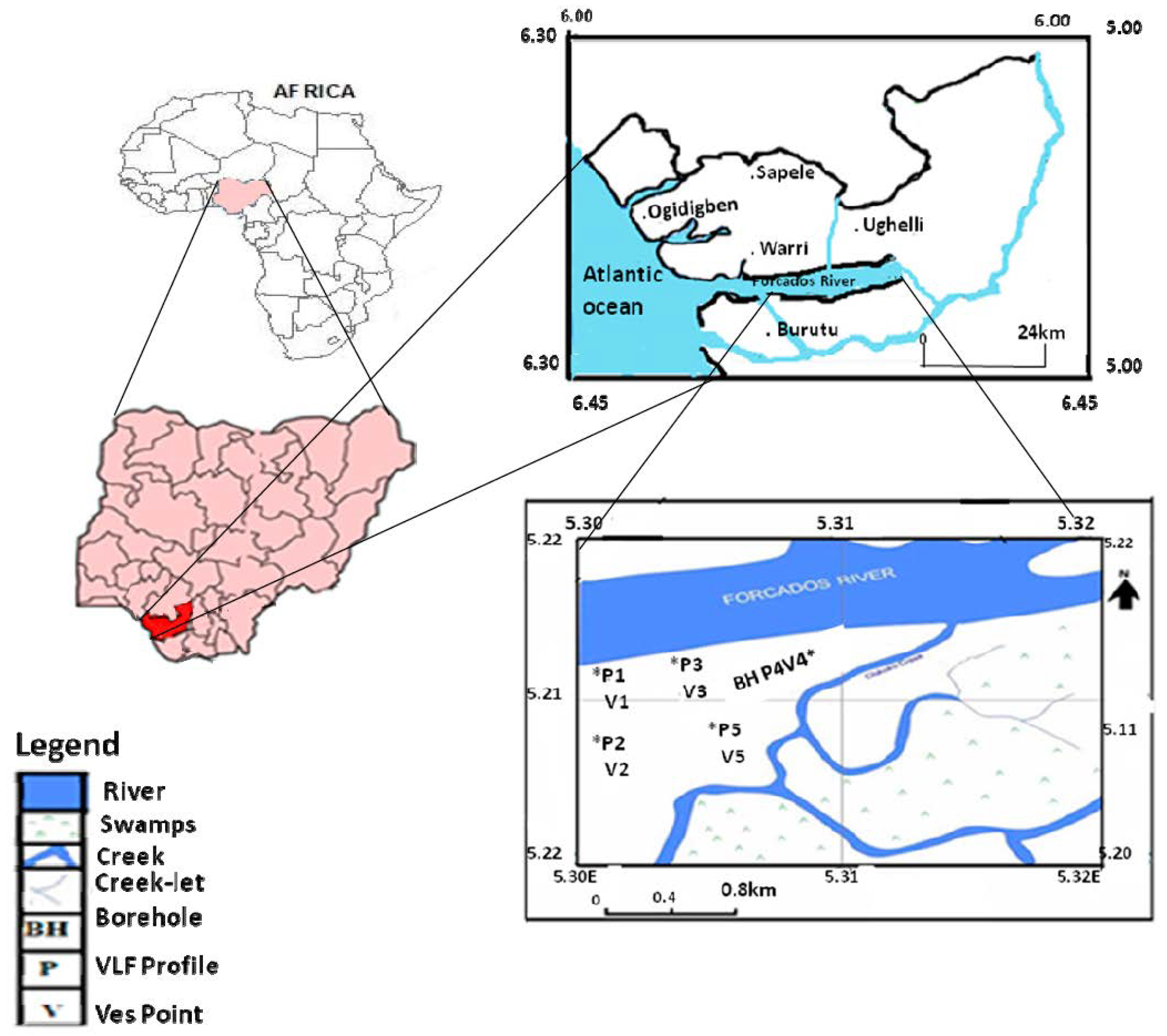
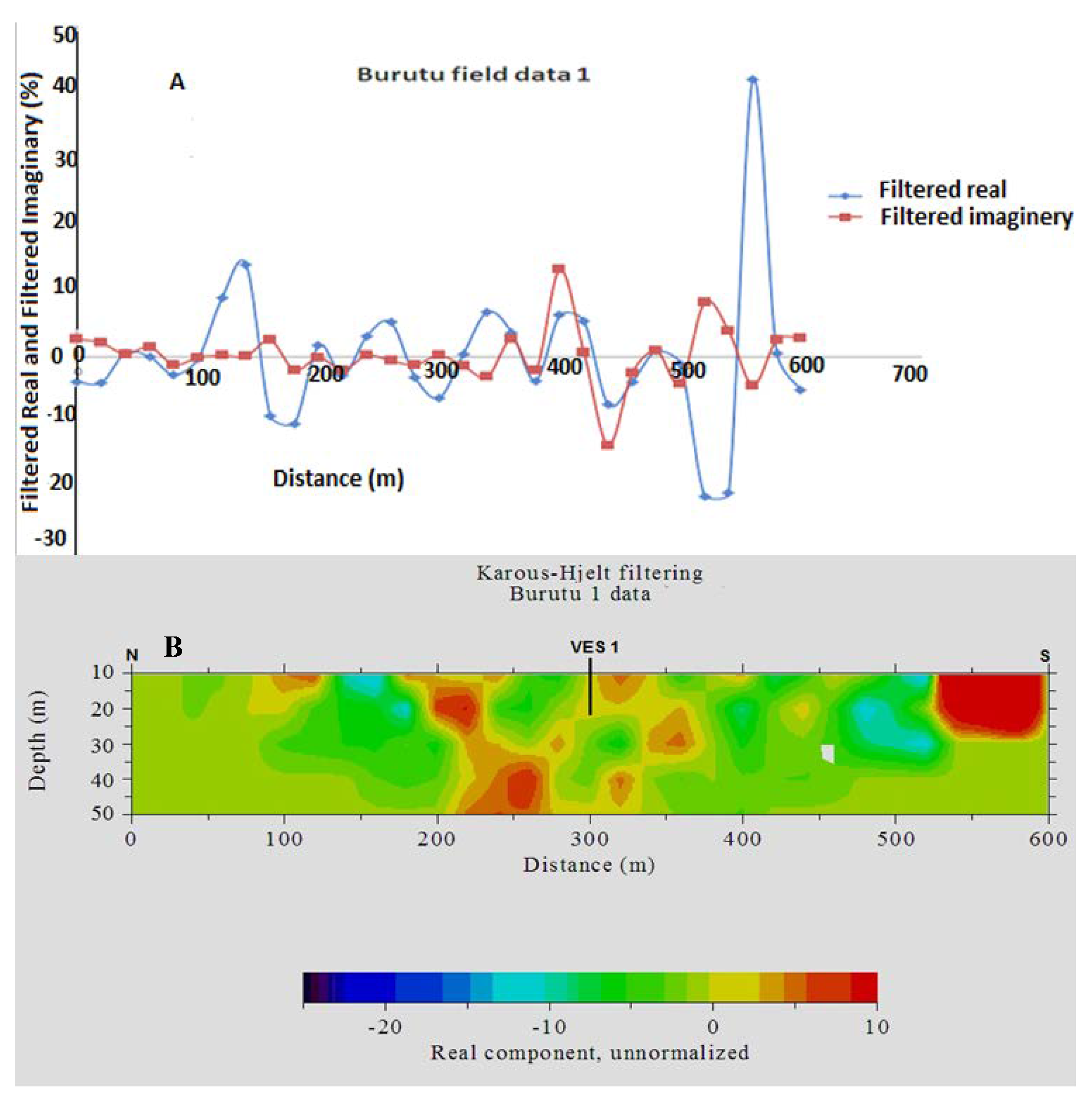
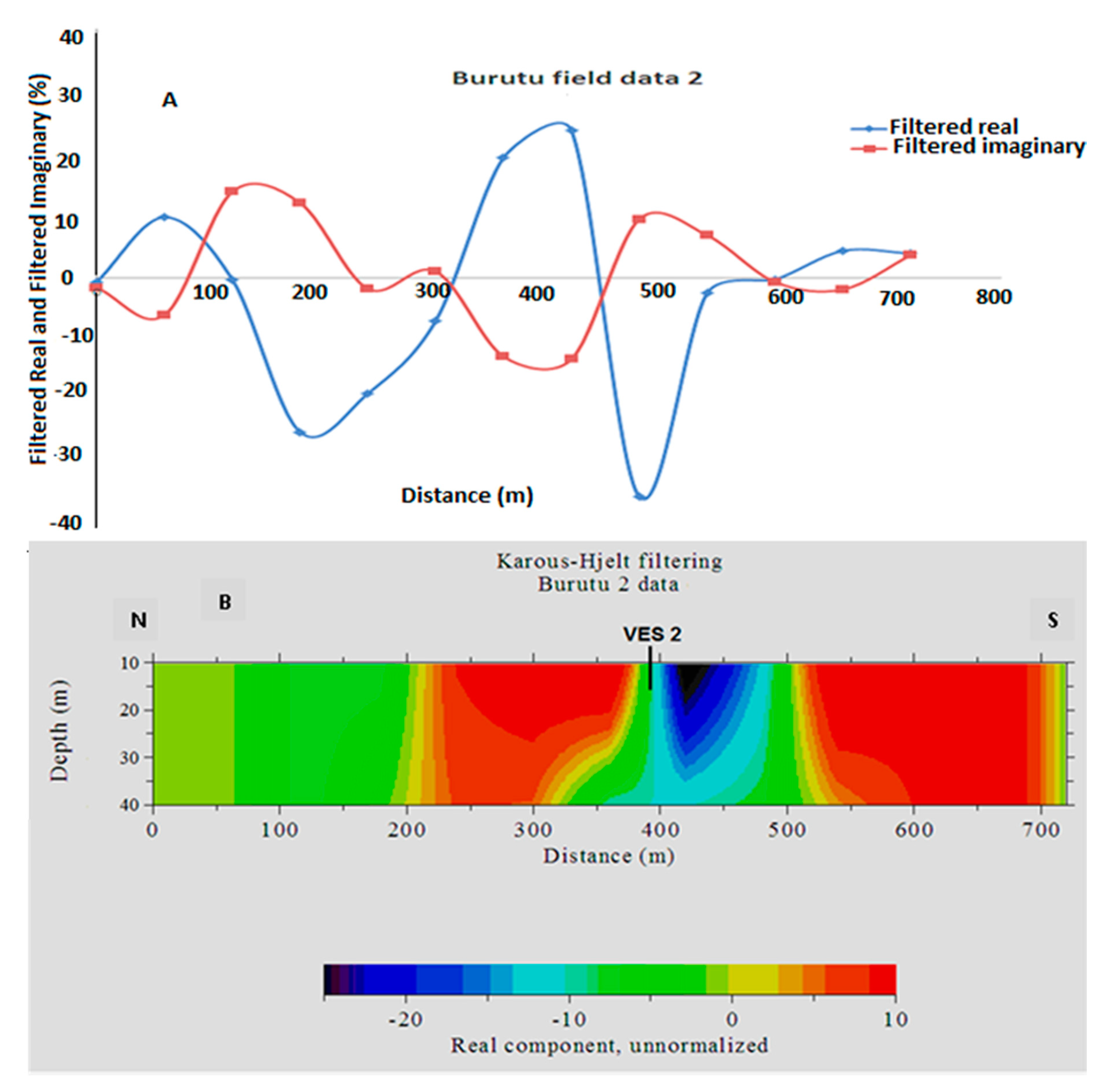

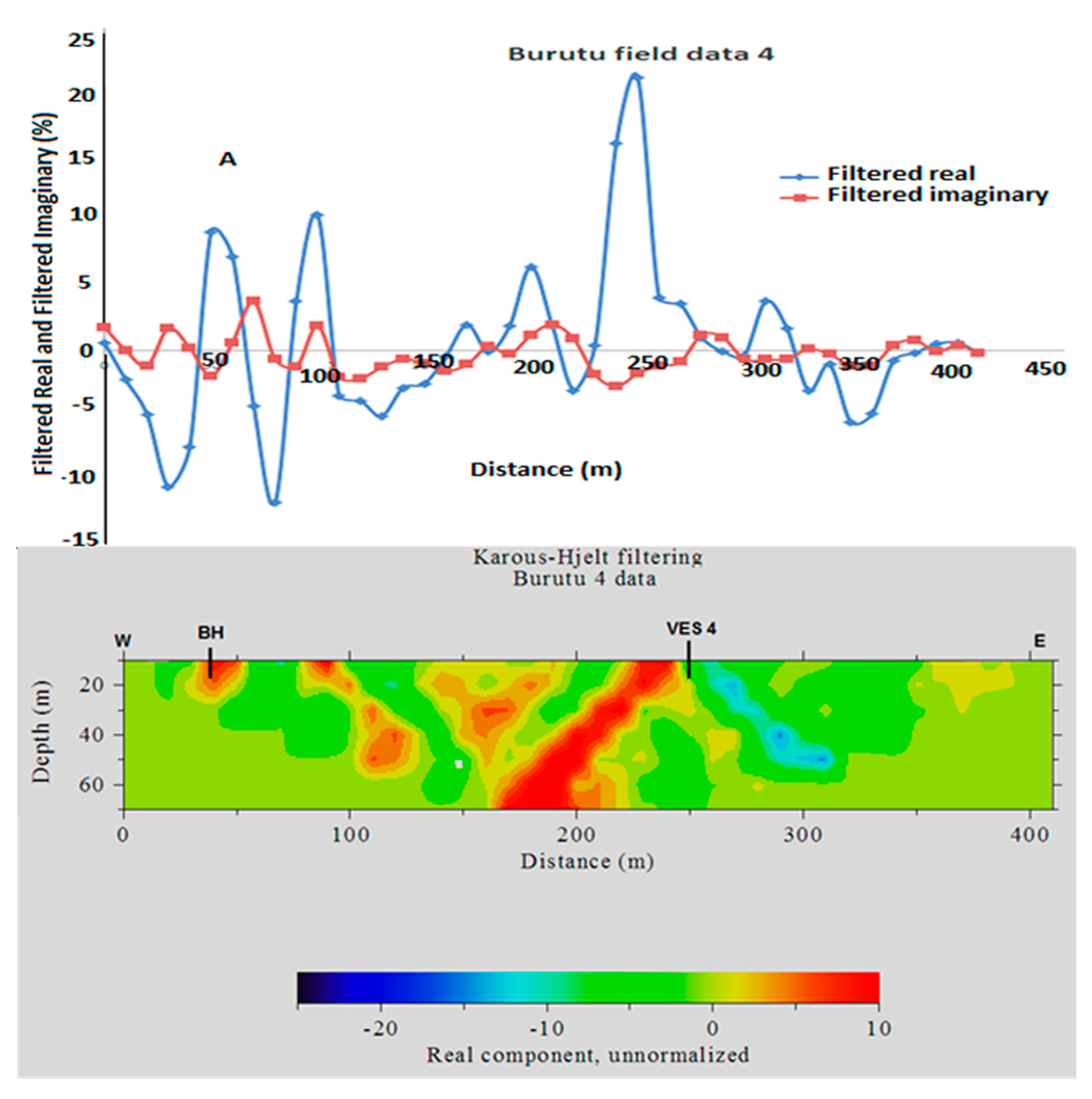

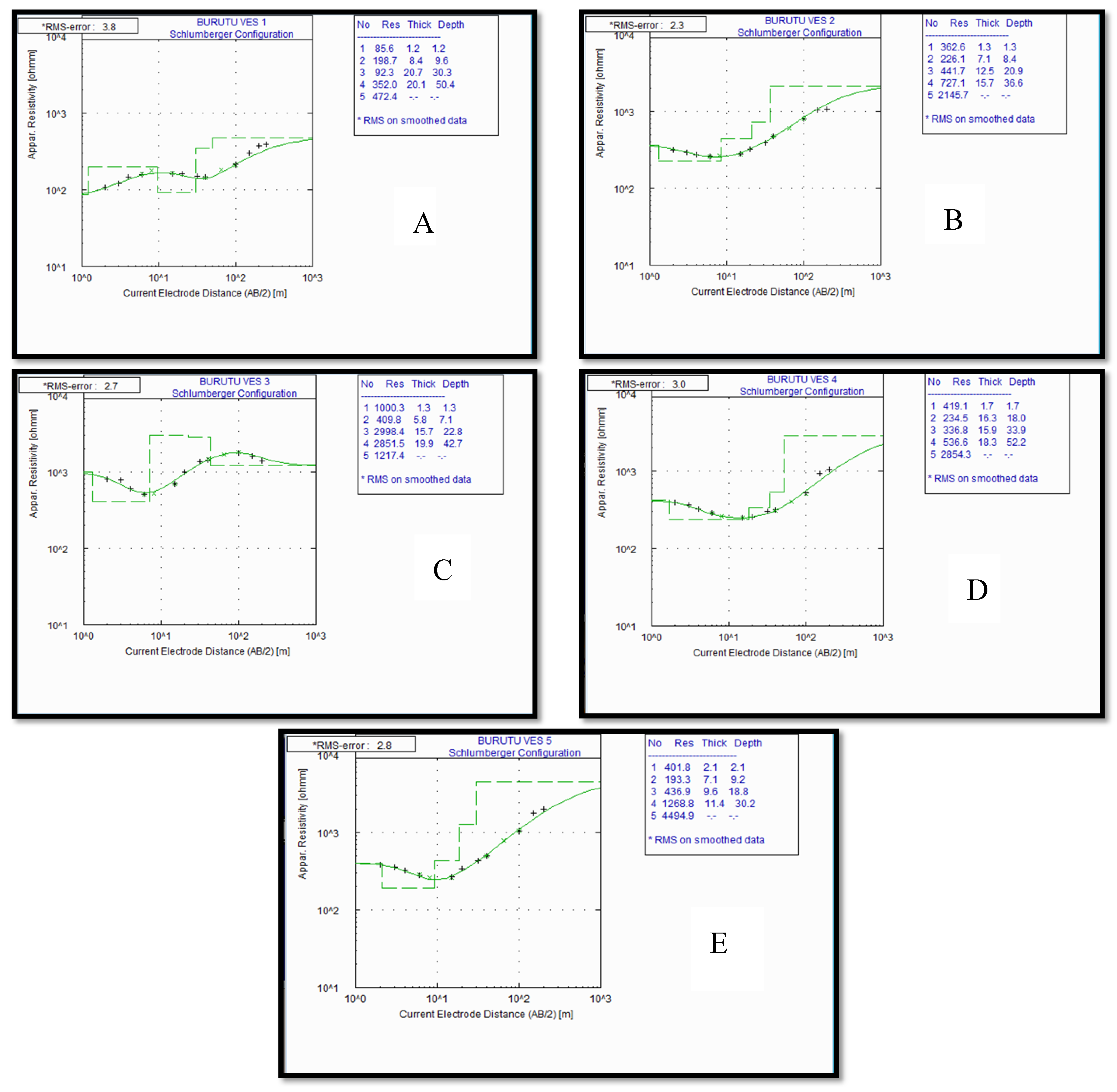
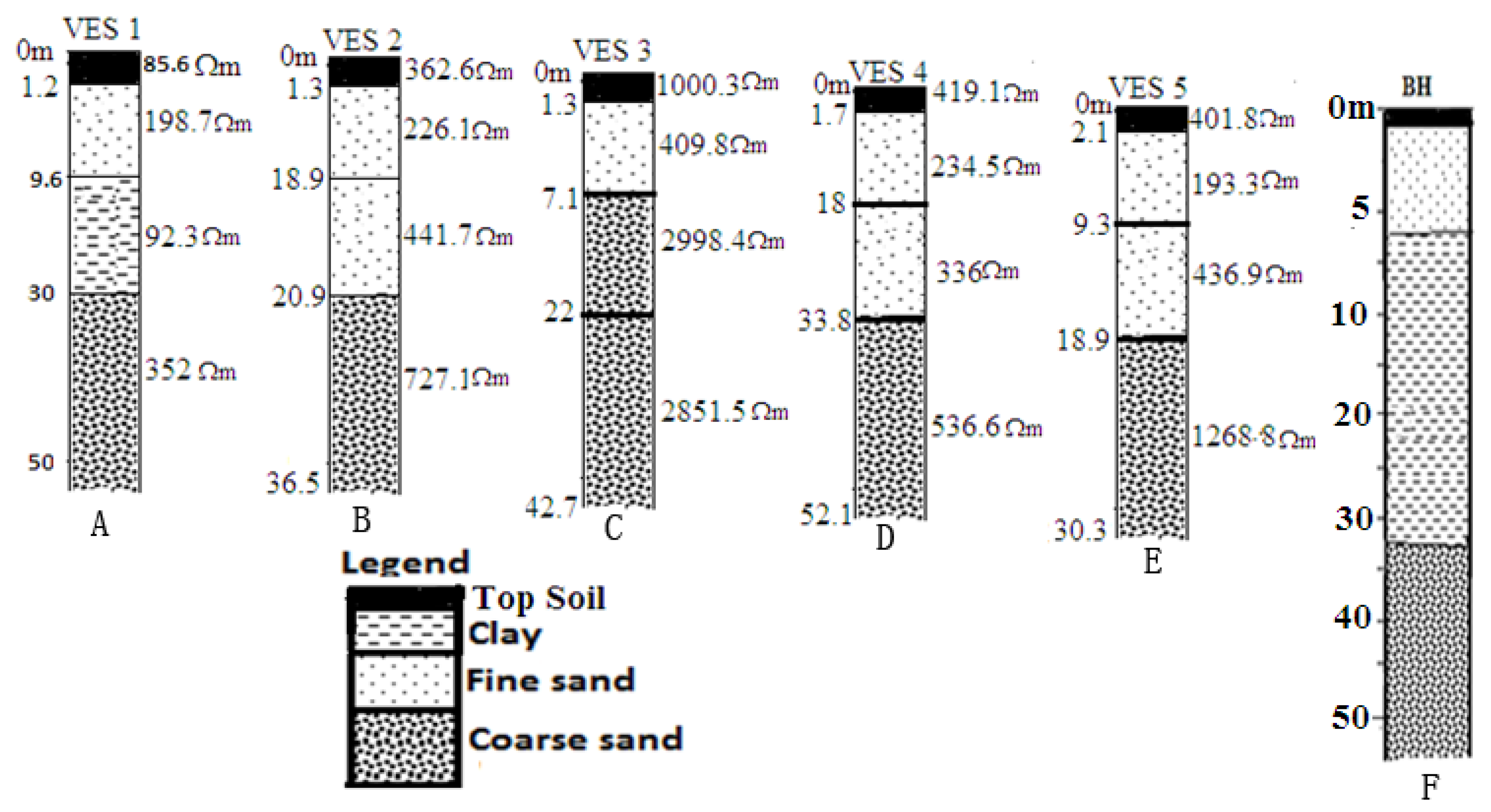
| Outcropping Units | Surface Units | Present-Day Equivalent |
|---|---|---|
| Benin Formation | Benin Formation | Continental (Fluviatile) mainly sandstone |
| Ogwashi-Asaba FormationAmeki Formatio | Agbada Formation | Mixed continental brackish water marine deposits, sandstone and clay |
| Imo shales | Akata Formation | Marine deposits, mainly clays |
© 2018 by the authors. Licensee MDPI, Basel, Switzerland. This article is an open access article distributed under the terms and conditions of the Creative Commons Attribution (CC BY) license (http://creativecommons.org/licenses/by/4.0/).
Share and Cite
Ohwoghere-Asuma, O.; Aweto, K.E.; Chinyem, F.I.; Nwankwoala, H.O. Assessing the Protective Capacity of Aquifers Using Very-Low-Frequency Electromagnetic Survey. Geosciences 2018, 8, 150. https://doi.org/10.3390/geosciences8050150
Ohwoghere-Asuma O, Aweto KE, Chinyem FI, Nwankwoala HO. Assessing the Protective Capacity of Aquifers Using Very-Low-Frequency Electromagnetic Survey. Geosciences. 2018; 8(5):150. https://doi.org/10.3390/geosciences8050150
Chicago/Turabian StyleOhwoghere-Asuma, Oghenero, Kizito Ejiro Aweto, Felix I. Chinyem, and Hyacinth O. Nwankwoala. 2018. "Assessing the Protective Capacity of Aquifers Using Very-Low-Frequency Electromagnetic Survey" Geosciences 8, no. 5: 150. https://doi.org/10.3390/geosciences8050150





